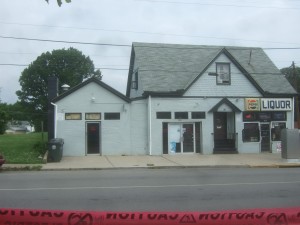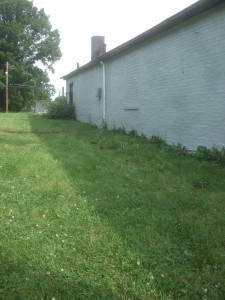In-feed joins growing list of gardening groups
NoC News
On Saturday morning, June 5, less than twelve hours after a fatal shooting a block away, two members of In-Feed and a lone volunteer helped plant a garden on the grassy vacant lot located across the street from the old Spauldings Building on the 500 block of North Limestone. The urban gardeners put in tomato and basil plants and, from seed, bush beans, okra and sunflowers.
The small reclamation of the grassy lot was organized by In-Feed, a group challenging the widespread mis-use of green space in a region where 1 in 7 inhabitants rely on food banks for some form of nourishment during the course of the year and, more specifically, in a part of the city where mean annual incomes remain below $20,000 per year. In-Feed’s strategy is to push for making unused city land more productive and beholden to the immediate communities in which those lots exist. As the group’s mission statement puts it, “We want unused land to be made available for urban gardening.” The North Limestone garden was the first of two gardens the group would put up that day around downtown.
The appearance of a vacant lot gardening group in Lexington is an offshoot of the growing diversity of activist city gardeners. In the past several years, community gardening groups Seedleaf and the Jim Embry-led Sustain Lex have (for good reason) gotten much of the publicity and community support for their excellent work in re-fusing communities to agricultural pursuits. Such pursuits have given rise to a number of other newer, less publicized and supported, groups who have related, but different, methods and tactics for supporting city gardening and food initiatives.
BCTC’s PeaceMeal Gardens uses a 2 acre farm just outside New Circle to provide subsidized food to its economically disadvantaged student (and staff) body; John Walker’s Lexington Urban Gleaners collect unused fruit and vegetables from farmers and backyard gardeners to distribute to food banks; the Lexington Free Store gives away free produce collected from a number of guerrilla gardened sites at a weekly inner-city market; and throughout the city nameless thousands share their extra bounties with friends and neighbors.
As Bob McKinley, who helped start In-Feed, noted, community gardening in Lexington is amply represented by Seedleaf and Jim Embry. McKinley wanted instead to provide a different outlet for community gardening initiatives. In Feed’s focus on vacant lots moves community gardening initiatives away from the Church/School/Park trinity of gardening spaces and instead begins to put the question of “usable” space to private landholders who do not put their properties to use.
In this sense, In Feed has deep connections to guerrilla gardening initiatives that have employed vacant lot gardening of private property since the 1970s. Like guerrilla gardening, In Feed emphasizes that anyone may take produce from the garden, “no strings attached.” The one notable difference is that McKinley and In Feed ask property owners for permission, whereas much guerrilla gardening has its roots in the political proposition that unused land demands to be taken from its owner and delivered to the people, who will make it productive. (Sidenote: Where are the guerrilla gardeners in Lexington?)
While each of these Lexington gardening groups operate separately and focus on slightly different spaces and aspects of urban agriculture, they do all work together to provide each other help. In Feed, for example, relied on a number of the groups referenced above: Seedleaf will donate some tomato cages for the N. Limestone garden site; Ryan Koch of Seedleaf and John Walker of Urban Gleaners provided gardening help at In Feed’s seed sale last April, which provided start-up funds for the North Limestone plantings and other gardens In Feed will establish. At the sale, The Rock/La Roca Church (which established a garden through the work of Jim Embry’s Sustain Lex) helped provide seeds while Kids Cafe on Seventh Street (which itself has a Seedleaf-started raised bed garden to help feed the children that use it) helped package the seeds for the sale. The visible outgrowth of these sets of collaboration is the vacant lot garden on the 500 block of North Limestone.
Time will tell if the (supposedly “creative” and “actively engaged”) community embraces vacant lot gardening as much as it has community Church/School/Park gardening. Much like with Seedleaf, which this reporter had the pleasure to work with several years ago as it began to sprout as an organization, In Feed’s community support has started small—at least if the lone journalist/volunteer who showed up at 9:00 AM on a Saturday morning to help with the planting is any indication.
The lot’s owner, James Maxberry, however, did make an appearance at the groundbreaking. Maxberry owns and operates the liquor store on the southwest corner of Sixth and N. Limestone. His property stretches southward down the block and includes a brick building housing a barber shop, an upstairs apartment over the liquor store and the grassy area on which the new In Feed garden sits. “The lot’s empty,” Maxberry said when asked why he allowed the garden to be built on his land. “I’d love to do something beneficial with it.”
He paused for a moment before getting into his car, and then added, “It’s up to you all to keep it safe and tended.” He was speaking to this white reporter who had asked him about the lot, but his meaning should apply to anyone who lives in the area. Now that the garden is planted, it is up to us, the immediate community, to ensure that it gets established.
Read more about In Feed at their website, http://infeed.wordpress.com/






Leave a Reply